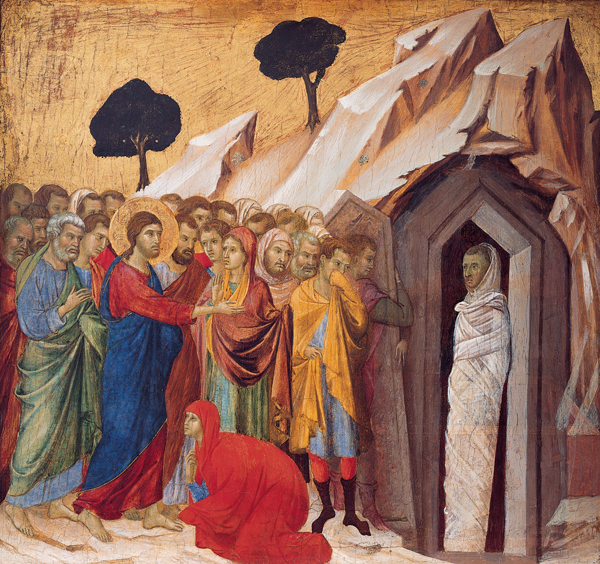Continuing from part #1 of my response to your comment under my 2014 post, "Shroud of Turin depicts a Y-shaped cross?," here is part #2
[Above (enlarge): "The Raising of Lazarus," by Duccio di Buoninsegna, 1310–11, Kimbell Art Museum. Note that this 1310–11 Christian artwork (in the 1260-1390 period that the 1988 radiocarbon dating of the Shroud claimed that it was forged), reflects the traditional (but wrong - see below) understanding at that time (and today - in 2023 our Pastor preached that Lazarus was bound like a mummy!) that Lazarus was bound from head to foot in linen bandages like an Egyptian mummy. So this is further evidence that the Shroud is not a medieval forgery, because a forger, to gain acceptance of his work, would reflect the then traditional view of Lazarus' burial.]
in response to your second point, "Wasn't Jesus wrapped like a mummy like Lazarus?" Again, your words are prefaced by ">" and in bold to distinguish them from mine.
>"Wasn't Jesus wrapped like a mummy like Lazarus?" No. The account of the raising of Lazarus is in John 11:43-44, where it plainly says that Lazarus' "hands and feet [were] bound with linen strips, and his face wrapped with a cloth:
"When he [Jesus] had said these things, he cried out with a loud voice, `Lazarus, come out.' The man who had died came out, his hands and feet bound with linen strips, and his face wrapped with a cloth. Jesus said to them, `Unbind him, and let him go.'".If Lazarus' whole body was bound with bandages as Egyptian mummies were, then there would be no point mentioning only Lazarus' "hands and feet" being bound. Moreover, as leading Shroud writer Ian Wilson pointed out, "Had Lazarus been swathed in bands, mummy fashion, it would have been impossible for him to move at all":
"Had Lazarus been swathed in bands, mummy fashion, it would have been impossible for him to move at all. Instead he appears to have been at least able to shuffle forward at the command `Come out,' requiring only the chin, hand, and foot bindings to be severed for him to resume normal life."[1]The fact is that, "Jews did not wrap up their dead like mummies, but laid them in shrouds":
"Furthermore, as seen earlier, Jewish burial customs do not support the idea that John's othonia refers to the wrappings of a mummy. Jews did not wrap up their dead like mummies, but laid them in shrouds, as indicated by the Gospel of John, the Essene burial procedures, and the Code of Jewish Law."[2]
Indeed, if Lazarus' and Jesus' bodies had been buried the same way as an Egyptian mummy was, they would also have had their internal organs removed and their bodies would have been embalmed, because that is what Egyptian mummification involved:
"Some of the details visible on the Shroud are consistent with such practices. As in Jewish custom we can be reasonably sure that the man of the Shroud was laid out flat and intact in some sort of prepared tomb. While this might seem obvious, it should be borne in mind that the Romans cremated their dead, and the Egyptians disemboweled and pickled them before swathing them in bandages."[3]The online Jewish Encyclopedia confirms that Jews were each buried in a shroud, even quoting "the New Testament" verse Mt 27:59, where "Joseph took the body [of Jesus] and wrapped it in a clean linen shroud":
"SHROUD ...Robe in which the dead are arrayed for burial. The shroud is made of white linen cloth (`sadin,' the σινδον [sindon] of the New Testament; see Matt. xxvii. 59), which is cut and sewed together with large stitches; the ends of the thread are left unknotted, the garment being intended to last only until the body has decayed. As a general rule, however, several garments are used instead of a single shroud; in the case of a man these are a cap (in the form of a miter), breeches, shirt, an over-garment somewhat similar to a surplice, and a girdle."[4]As mentioned in the above entry, the burial shroud would normally have been over a dead Jew's clothes, which would presumably have been the case with Lazarus; but Jesus was naked, His clothes having been taken by His Roman executioners (Mt 27:35; Mk 15:24; Lk 23:34; Jn 19:24)[5].
Continued in part #3, "Wasn't Jesus' body washed before putting it in the grave?"
Notes
1. . Wilson, I., 1979, "The Shroud of Turin: The Burial Cloth of Jesus?," [1978], Image Books: New York NY, Revised edition, p.53). [return]
2. Stevenson, K.E. & Habermas, G.R., 1981, "Verdict on the Shroud: Evidence for the Death and Resurrection of Jesus Christ," Servant Books: Ann Arbor MI, p.49. [return]
3. Wilson, 1979, pp.53-54. [return]
4. Adler, C. & Eisenstein, J.D., 1906, "Shroud," The Jewish Encyclopedia. [return]
5. Wilson, I., 2010, "The Shroud: The 2000-Year-Old Mystery Solved," Bantam Press: London, p.52. [return]
Posted 29 September 2015. Updated 4 April 2025.
Thank you so much. I was wonderfully impressed.
ReplyDeleteUnknown
ReplyDelete>Thank you so much. I was wonderfully impressed.
Thank you. Although you probably won't see his because my publishing of it is ~6 years late!
Blogger does not always notify me by email that I have comments pending, and I am working through my backlog of same.
Stephen E. Jones
----------------------------------
MY POLICIES. Comments are moderated. Those I consider off-topic, offensive or sub-standard will not appear. Except that comments under my current post can be on any Shroud-related topic without being off-topic. To avoid time-wasting debate (2Tim 2:23; Titus 3:9), I normally allow only one comment per individual under each one of my posts. I reserve the right to respond to any comment as a separate blog post.